Line 1 (Beijing Subway)
Line 1 of the Beijing Subway (Chinese: 北京地铁1号线; pinyin: běijīng dìtiě yīhào xiàn) is the oldest and one of the busiest lines of Beijing's mass transit rail network. Line 1 runs underneath Chang'an Avenue, the city's grand east–west thoroughfare, right through the heart of Beijing with stops on either side of Tiananmen Square. Line 1's color is red. As the oldest line of the Beijing Subway, Line 1 was also the most heavily used from the time the subway opened in 1969 until January 2013, when the near-completion of the Line 10 loop caused ridership on that line to surge past Line 1. Recent traffic relief efforts have been completed in recent years. The opening of the first phase of the parallel Line 6, caused an 8.46% decrease in daily demand and a 10-20% reduction in peak flow during rush hour.[8] In addition Beijing BRT line 2 parallels the eastern section of Line 1. However, during peak hours, sections of the line were reported in 2013 to still operate above 100% capacity.[8]
| Line 1 | ||||||||||||||||||||||||||||||||||||||||||||||||||||||||||||||||||||||||||||||||||||||||||||||||||||||||||||||||||||||||||||||||||||||||||||||||||||||||||||||||||||||||||||||||||||||||||||||||||||||||||||||||||||||||||||||||||||||||||||||||||||||||||||||||||||||||||||||||||||||||||||||||||||||||||||||||||||||||||||||||||||||||||||||||||||||||||||||||||||||||||||||||||||||||||||||||||||||||||||||||||||||||||||||||||||||||||||||||||||||||||||||||||||||||||||||||||||||||||||||||||||||||||||||||||||||||||||||
|---|---|---|---|---|---|---|---|---|---|---|---|---|---|---|---|---|---|---|---|---|---|---|---|---|---|---|---|---|---|---|---|---|---|---|---|---|---|---|---|---|---|---|---|---|---|---|---|---|---|---|---|---|---|---|---|---|---|---|---|---|---|---|---|---|---|---|---|---|---|---|---|---|---|---|---|---|---|---|---|---|---|---|---|---|---|---|---|---|---|---|---|---|---|---|---|---|---|---|---|---|---|---|---|---|---|---|---|---|---|---|---|---|---|---|---|---|---|---|---|---|---|---|---|---|---|---|---|---|---|---|---|---|---|---|---|---|---|---|---|---|---|---|---|---|---|---|---|---|---|---|---|---|---|---|---|---|---|---|---|---|---|---|---|---|---|---|---|---|---|---|---|---|---|---|---|---|---|---|---|---|---|---|---|---|---|---|---|---|---|---|---|---|---|---|---|---|---|---|---|---|---|---|---|---|---|---|---|---|---|---|---|---|---|---|---|---|---|---|---|---|---|---|---|---|---|---|---|---|---|---|---|---|---|---|---|---|---|---|---|---|---|---|---|---|---|---|---|---|---|---|---|---|---|---|---|---|---|---|---|---|---|---|---|---|---|---|---|---|---|---|---|---|---|---|---|---|---|---|---|---|---|---|---|---|---|---|---|---|---|---|---|---|---|---|---|---|---|---|---|---|---|---|---|---|---|---|---|---|---|---|---|---|---|---|---|---|---|---|---|---|---|---|---|---|---|---|---|---|---|---|---|---|---|---|---|---|---|---|---|---|---|---|---|---|---|---|---|---|---|---|---|---|---|---|---|---|---|---|---|---|---|---|---|---|---|---|---|---|---|---|---|---|---|---|---|---|---|---|---|---|---|---|---|---|---|---|---|---|---|---|---|---|---|---|---|---|---|---|---|---|---|---|---|---|---|---|---|---|---|---|---|---|---|---|---|---|---|---|---|---|---|---|---|---|---|---|---|---|---|---|---|---|---|---|---|---|---|---|---|---|---|---|---|---|---|---|---|---|---|---|---|---|---|---|---|---|---|---|---|---|---|---|---|---|---|---|---|---|---|---|---|---|---|---|---|---|---|---|---|---|---|---|---|---|---|---|---|---|---|---|---|---|---|---|---|---|---|---|---|---|---|---|---|---|---|---|---|---|---|---|
| 1 | ||||||||||||||||||||||||||||||||||||||||||||||||||||||||||||||||||||||||||||||||||||||||||||||||||||||||||||||||||||||||||||||||||||||||||||||||||||||||||||||||||||||||||||||||||||||||||||||||||||||||||||||||||||||||||||||||||||||||||||||||||||||||||||||||||||||||||||||||||||||||||||||||||||||||||||||||||||||||||||||||||||||||||||||||||||||||||||||||||||||||||||||||||||||||||||||||||||||||||||||||||||||||||||||||||||||||||||||||||||||||||||||||||||||||||||||||||||||||||||||||||||||||||||||||||||||||||||||
.jpg) | ||||||||||||||||||||||||||||||||||||||||||||||||||||||||||||||||||||||||||||||||||||||||||||||||||||||||||||||||||||||||||||||||||||||||||||||||||||||||||||||||||||||||||||||||||||||||||||||||||||||||||||||||||||||||||||||||||||||||||||||||||||||||||||||||||||||||||||||||||||||||||||||||||||||||||||||||||||||||||||||||||||||||||||||||||||||||||||||||||||||||||||||||||||||||||||||||||||||||||||||||||||||||||||||||||||||||||||||||||||||||||||||||||||||||||||||||||||||||||||||||||||||||||||||||||||||||||||||
| Overview | ||||||||||||||||||||||||||||||||||||||||||||||||||||||||||||||||||||||||||||||||||||||||||||||||||||||||||||||||||||||||||||||||||||||||||||||||||||||||||||||||||||||||||||||||||||||||||||||||||||||||||||||||||||||||||||||||||||||||||||||||||||||||||||||||||||||||||||||||||||||||||||||||||||||||||||||||||||||||||||||||||||||||||||||||||||||||||||||||||||||||||||||||||||||||||||||||||||||||||||||||||||||||||||||||||||||||||||||||||||||||||||||||||||||||||||||||||||||||||||||||||||||||||||||||||||||||||||||
| Other name(s) | M1 (planned name) Fuba line (Chinese: 复八线) | |||||||||||||||||||||||||||||||||||||||||||||||||||||||||||||||||||||||||||||||||||||||||||||||||||||||||||||||||||||||||||||||||||||||||||||||||||||||||||||||||||||||||||||||||||||||||||||||||||||||||||||||||||||||||||||||||||||||||||||||||||||||||||||||||||||||||||||||||||||||||||||||||||||||||||||||||||||||||||||||||||||||||||||||||||||||||||||||||||||||||||||||||||||||||||||||||||||||||||||||||||||||||||||||||||||||||||||||||||||||||||||||||||||||||||||||||||||||||||||||||||||||||||||||||||||||||||||
| Type | Rapid transit | |||||||||||||||||||||||||||||||||||||||||||||||||||||||||||||||||||||||||||||||||||||||||||||||||||||||||||||||||||||||||||||||||||||||||||||||||||||||||||||||||||||||||||||||||||||||||||||||||||||||||||||||||||||||||||||||||||||||||||||||||||||||||||||||||||||||||||||||||||||||||||||||||||||||||||||||||||||||||||||||||||||||||||||||||||||||||||||||||||||||||||||||||||||||||||||||||||||||||||||||||||||||||||||||||||||||||||||||||||||||||||||||||||||||||||||||||||||||||||||||||||||||||||||||||||||||||||||
| System | Beijing Subway | |||||||||||||||||||||||||||||||||||||||||||||||||||||||||||||||||||||||||||||||||||||||||||||||||||||||||||||||||||||||||||||||||||||||||||||||||||||||||||||||||||||||||||||||||||||||||||||||||||||||||||||||||||||||||||||||||||||||||||||||||||||||||||||||||||||||||||||||||||||||||||||||||||||||||||||||||||||||||||||||||||||||||||||||||||||||||||||||||||||||||||||||||||||||||||||||||||||||||||||||||||||||||||||||||||||||||||||||||||||||||||||||||||||||||||||||||||||||||||||||||||||||||||||||||||||||||||||
| Status | Operational | |||||||||||||||||||||||||||||||||||||||||||||||||||||||||||||||||||||||||||||||||||||||||||||||||||||||||||||||||||||||||||||||||||||||||||||||||||||||||||||||||||||||||||||||||||||||||||||||||||||||||||||||||||||||||||||||||||||||||||||||||||||||||||||||||||||||||||||||||||||||||||||||||||||||||||||||||||||||||||||||||||||||||||||||||||||||||||||||||||||||||||||||||||||||||||||||||||||||||||||||||||||||||||||||||||||||||||||||||||||||||||||||||||||||||||||||||||||||||||||||||||||||||||||||||||||||||||||
| Locale | Chaoyang, Dongcheng, Xicheng, Haidian, and Shijingshan districts Beijing | |||||||||||||||||||||||||||||||||||||||||||||||||||||||||||||||||||||||||||||||||||||||||||||||||||||||||||||||||||||||||||||||||||||||||||||||||||||||||||||||||||||||||||||||||||||||||||||||||||||||||||||||||||||||||||||||||||||||||||||||||||||||||||||||||||||||||||||||||||||||||||||||||||||||||||||||||||||||||||||||||||||||||||||||||||||||||||||||||||||||||||||||||||||||||||||||||||||||||||||||||||||||||||||||||||||||||||||||||||||||||||||||||||||||||||||||||||||||||||||||||||||||||||||||||||||||||||||
| Termini | Gucheng (Pingguoyuan reopens in 2021) Sihui East | |||||||||||||||||||||||||||||||||||||||||||||||||||||||||||||||||||||||||||||||||||||||||||||||||||||||||||||||||||||||||||||||||||||||||||||||||||||||||||||||||||||||||||||||||||||||||||||||||||||||||||||||||||||||||||||||||||||||||||||||||||||||||||||||||||||||||||||||||||||||||||||||||||||||||||||||||||||||||||||||||||||||||||||||||||||||||||||||||||||||||||||||||||||||||||||||||||||||||||||||||||||||||||||||||||||||||||||||||||||||||||||||||||||||||||||||||||||||||||||||||||||||||||||||||||||||||||||
| Stations | 23 | |||||||||||||||||||||||||||||||||||||||||||||||||||||||||||||||||||||||||||||||||||||||||||||||||||||||||||||||||||||||||||||||||||||||||||||||||||||||||||||||||||||||||||||||||||||||||||||||||||||||||||||||||||||||||||||||||||||||||||||||||||||||||||||||||||||||||||||||||||||||||||||||||||||||||||||||||||||||||||||||||||||||||||||||||||||||||||||||||||||||||||||||||||||||||||||||||||||||||||||||||||||||||||||||||||||||||||||||||||||||||||||||||||||||||||||||||||||||||||||||||||||||||||||||||||||||||||||
| Daily ridership | 1,234,900 (2014 Avg.)[1] 1,536,900 (2014 Peak)[2][3] | |||||||||||||||||||||||||||||||||||||||||||||||||||||||||||||||||||||||||||||||||||||||||||||||||||||||||||||||||||||||||||||||||||||||||||||||||||||||||||||||||||||||||||||||||||||||||||||||||||||||||||||||||||||||||||||||||||||||||||||||||||||||||||||||||||||||||||||||||||||||||||||||||||||||||||||||||||||||||||||||||||||||||||||||||||||||||||||||||||||||||||||||||||||||||||||||||||||||||||||||||||||||||||||||||||||||||||||||||||||||||||||||||||||||||||||||||||||||||||||||||||||||||||||||||||||||||||||
| Operation | ||||||||||||||||||||||||||||||||||||||||||||||||||||||||||||||||||||||||||||||||||||||||||||||||||||||||||||||||||||||||||||||||||||||||||||||||||||||||||||||||||||||||||||||||||||||||||||||||||||||||||||||||||||||||||||||||||||||||||||||||||||||||||||||||||||||||||||||||||||||||||||||||||||||||||||||||||||||||||||||||||||||||||||||||||||||||||||||||||||||||||||||||||||||||||||||||||||||||||||||||||||||||||||||||||||||||||||||||||||||||||||||||||||||||||||||||||||||||||||||||||||||||||||||||||||||||||||||
| Opened | January 15, 1971 | |||||||||||||||||||||||||||||||||||||||||||||||||||||||||||||||||||||||||||||||||||||||||||||||||||||||||||||||||||||||||||||||||||||||||||||||||||||||||||||||||||||||||||||||||||||||||||||||||||||||||||||||||||||||||||||||||||||||||||||||||||||||||||||||||||||||||||||||||||||||||||||||||||||||||||||||||||||||||||||||||||||||||||||||||||||||||||||||||||||||||||||||||||||||||||||||||||||||||||||||||||||||||||||||||||||||||||||||||||||||||||||||||||||||||||||||||||||||||||||||||||||||||||||||||||||||||||||
| Operator(s) | Beijing Mass Transit Railway Operation Corp., Ltd. | |||||||||||||||||||||||||||||||||||||||||||||||||||||||||||||||||||||||||||||||||||||||||||||||||||||||||||||||||||||||||||||||||||||||||||||||||||||||||||||||||||||||||||||||||||||||||||||||||||||||||||||||||||||||||||||||||||||||||||||||||||||||||||||||||||||||||||||||||||||||||||||||||||||||||||||||||||||||||||||||||||||||||||||||||||||||||||||||||||||||||||||||||||||||||||||||||||||||||||||||||||||||||||||||||||||||||||||||||||||||||||||||||||||||||||||||||||||||||||||||||||||||||||||||||||||||||||||
| Character | Underground, at-grade[lower-alpha 1] | |||||||||||||||||||||||||||||||||||||||||||||||||||||||||||||||||||||||||||||||||||||||||||||||||||||||||||||||||||||||||||||||||||||||||||||||||||||||||||||||||||||||||||||||||||||||||||||||||||||||||||||||||||||||||||||||||||||||||||||||||||||||||||||||||||||||||||||||||||||||||||||||||||||||||||||||||||||||||||||||||||||||||||||||||||||||||||||||||||||||||||||||||||||||||||||||||||||||||||||||||||||||||||||||||||||||||||||||||||||||||||||||||||||||||||||||||||||||||||||||||||||||||||||||||||||||||||||
| Depot(s) | Guchenglu, Sihui Depots [4][5] | |||||||||||||||||||||||||||||||||||||||||||||||||||||||||||||||||||||||||||||||||||||||||||||||||||||||||||||||||||||||||||||||||||||||||||||||||||||||||||||||||||||||||||||||||||||||||||||||||||||||||||||||||||||||||||||||||||||||||||||||||||||||||||||||||||||||||||||||||||||||||||||||||||||||||||||||||||||||||||||||||||||||||||||||||||||||||||||||||||||||||||||||||||||||||||||||||||||||||||||||||||||||||||||||||||||||||||||||||||||||||||||||||||||||||||||||||||||||||||||||||||||||||||||||||||||||||||||
| Rolling stock | 6-car Type B (DKZ4, SFM04) | |||||||||||||||||||||||||||||||||||||||||||||||||||||||||||||||||||||||||||||||||||||||||||||||||||||||||||||||||||||||||||||||||||||||||||||||||||||||||||||||||||||||||||||||||||||||||||||||||||||||||||||||||||||||||||||||||||||||||||||||||||||||||||||||||||||||||||||||||||||||||||||||||||||||||||||||||||||||||||||||||||||||||||||||||||||||||||||||||||||||||||||||||||||||||||||||||||||||||||||||||||||||||||||||||||||||||||||||||||||||||||||||||||||||||||||||||||||||||||||||||||||||||||||||||||||||||||||
| Technical | ||||||||||||||||||||||||||||||||||||||||||||||||||||||||||||||||||||||||||||||||||||||||||||||||||||||||||||||||||||||||||||||||||||||||||||||||||||||||||||||||||||||||||||||||||||||||||||||||||||||||||||||||||||||||||||||||||||||||||||||||||||||||||||||||||||||||||||||||||||||||||||||||||||||||||||||||||||||||||||||||||||||||||||||||||||||||||||||||||||||||||||||||||||||||||||||||||||||||||||||||||||||||||||||||||||||||||||||||||||||||||||||||||||||||||||||||||||||||||||||||||||||||||||||||||||||||||||||
| Line length | 31.04 km (19.29 mi)[6] | |||||||||||||||||||||||||||||||||||||||||||||||||||||||||||||||||||||||||||||||||||||||||||||||||||||||||||||||||||||||||||||||||||||||||||||||||||||||||||||||||||||||||||||||||||||||||||||||||||||||||||||||||||||||||||||||||||||||||||||||||||||||||||||||||||||||||||||||||||||||||||||||||||||||||||||||||||||||||||||||||||||||||||||||||||||||||||||||||||||||||||||||||||||||||||||||||||||||||||||||||||||||||||||||||||||||||||||||||||||||||||||||||||||||||||||||||||||||||||||||||||||||||||||||||||||||||||||
| Track gauge | 1,435 mm (4 ft 8 1⁄2 in) | |||||||||||||||||||||||||||||||||||||||||||||||||||||||||||||||||||||||||||||||||||||||||||||||||||||||||||||||||||||||||||||||||||||||||||||||||||||||||||||||||||||||||||||||||||||||||||||||||||||||||||||||||||||||||||||||||||||||||||||||||||||||||||||||||||||||||||||||||||||||||||||||||||||||||||||||||||||||||||||||||||||||||||||||||||||||||||||||||||||||||||||||||||||||||||||||||||||||||||||||||||||||||||||||||||||||||||||||||||||||||||||||||||||||||||||||||||||||||||||||||||||||||||||||||||||||||||||
| Operating speed | 80 km/h (maximum service speed) | |||||||||||||||||||||||||||||||||||||||||||||||||||||||||||||||||||||||||||||||||||||||||||||||||||||||||||||||||||||||||||||||||||||||||||||||||||||||||||||||||||||||||||||||||||||||||||||||||||||||||||||||||||||||||||||||||||||||||||||||||||||||||||||||||||||||||||||||||||||||||||||||||||||||||||||||||||||||||||||||||||||||||||||||||||||||||||||||||||||||||||||||||||||||||||||||||||||||||||||||||||||||||||||||||||||||||||||||||||||||||||||||||||||||||||||||||||||||||||||||||||||||||||||||||||||||||||||
| ||||||||||||||||||||||||||||||||||||||||||||||||||||||||||||||||||||||||||||||||||||||||||||||||||||||||||||||||||||||||||||||||||||||||||||||||||||||||||||||||||||||||||||||||||||||||||||||||||||||||||||||||||||||||||||||||||||||||||||||||||||||||||||||||||||||||||||||||||||||||||||||||||||||||||||||||||||||||||||||||||||||||||||||||||||||||||||||||||||||||||||||||||||||||||||||||||||||||||||||||||||||||||||||||||||||||||||||||||||||||||||||||||||||||||||||||||||||||||||||||||||||||||||||||||||||||||||||
Hours of operation
The first east-bound trains departs from Gucheng at 4:58am and Pingguoyuan at 5:10am. The first west-bound train departs Sihui at 4:56am and Sihui East at 5:05am. The last east-bound train leaves Pingguoyuan at 10:55pm. The last west-bound train leaves Sihui East at 11:15pm. For the official timetable, see.[9]
Route
Line 1's western terminus is Pingguoyuan, located in Shijingshan District. The line heads southeast to its second stop at Gucheng and from there runs straight east, following Chang'an Avenue all the way to its eastern terminus, Sihui East in Chaoyang District, just beyond the 4th Ring Road. The line passes through Xidan, Wangfujing and Dongdan, among other important commercial centers of Xicheng and Dongcheng Districts, as well as the Beijing CBD near the China World Trade Center. The line is 31.04 km (19.29 mi)[6] in length with 23 stations in operation. All stations except for Sihui and Sihui East are underground.
Stations (from west to east)
| Station № |
Station Name | Connections | Nearby Bus Stops[10] | Travel Time | Distance km[11] |
Location | ||
|---|---|---|---|---|---|---|---|---|
| English | Chinese | |||||||
| 103 | Pingguoyuan | 苹果园 | 325 336 358 370 396 399 472 527 597 664 876 892 929 931 932 941快 948 961 972 977 977快 981 | 0:00 | 0.000 | 0.000 | Shijingshan | |
| 104 | Gucheng | 古城 | 318 327 337 399 597 941 958 959 992 夜5 专61 专108 | 0:04 | 2.606 | 2.606 | ||
| 105 | Bajiao Amusement Park | 八角游乐园 | 325 327 337 373 436 472 527 545 574 597 598 663 914 941 958 959 965 992 夜5 专46 专86 专91 | 0:07 | 1.921 | 4.527 | ||
| 106 | Babaoshan | 八宝山 | 1 76 337 373 420 527 545 546 574 597 610 914 941 951 961 979 夜1 专69 专109 | 0:10 | 1.953 | 6.480 | ||
| 107 | Yuquanlu | 玉泉路 | 1 76 78 337 338 370 373 389 420 436 452 472 473 481 507 610 612 644 736 941 941快 979 夜1 专11 | 0:12 | 1.479 | 7.959 | ||
| 108 | Wukesong | 五棵松 | 1 64 76 97 337 370 420 436 568 624 685 740 952 967 982 983 特9 夜1 专127 | 0:15 | 1.810 | 9.769 | Haidian | |
| 109 | Wanshoulu | 万寿路 | 1 32 33 64 68 76 77 89 308 335 337 370 420 624 627 夜1 夜5 夜16 | 0:18 | 1.778 | 11.547 | ||
| 110 | Gongzhufen | 公主坟 | 10 | 1 32 33 40 52 62 64 68 74 76 77 89 94 300 300快 308 323 335 337 370 374 394 420 437 491 603 624 631快 698 977 977快 特8 夜1 夜5 夜30 | 0:20 | 1.313 | 12.860 | |
| 111 | Military Museum | 军事博物馆 | 9 | 1 21 40 52 65 68 78 85 94 308 414 夜1 夜5 夜8 | 0:22 | 1.172 | 14.032 | |
| 112 | Muxidi | 木樨地 | 1 21 32 52 65 68 78 85 94 114 308 320 夜1 夜8 | 0:23 | 1.166 | 15.198 | Xicheng | |
| 113 | Nanlishilu | 南礼士路 | 1 3 10 15 19 42 46 49 52 56 夜1 夜8 夜12 | 0:25 | 1.291 | 16.489 | ||
| 114 | Fuxingmen | 复兴门 | 2 | 1 10 15 44 49 52 387 395 423 691 694 特4 特12 夜1 夜20 | 0:26 | 0.424 | 16.913 | |
| 115 | Xidan | 西单 | 4 | 1 15 22 52 70 83 88 102 105 109 332 特13 夜1 夜4 夜10 | 0:28 | 1.590 | 18.503 | |
| 116 | Tian'anmen West | 天安门西 | 1 5 52 观光1 观光2 夜1 | 0:30 | 1.217 | 19.720 | ||
| 117 | Tian'anmen East | 天安门东 | 1 2 52 82 120 观光1 观光2 夜1 夜2 夜17 | 0:32 | 0.925 | 20.645 | Dongcheng | |
| 118 | Wangfujing | 王府井 | 1 41 52 103 120 观光2 特11 夜1 夜17 夜18 夜21 | 0:33 | 0.852 | 21.497 | ||
| 119 | Dongdan | 东单 | 5 | 1 39 41 52 104 106 108 110 111 116 120 128 140 684 夜1 夜10 夜17 | 0:34 | 0.774 | 22.271 | |
| 120 | Jianguomen | 建国门 | 2 | 1 20 39 43 44 52 58 120 122 126 139 140 403 637 638 639 804 特2 特12 夜1 夜10 夜19 夜20 夜24 夜28 夜29 | 0:36 | 1.230 | 23.501 | Dongcheng[lower-alpha 2] |
| 121 | Yong'anli | 永安里 | 1 9 28 43 58 120 126 140 403 619 639 668 夜1 夜24 | 0:38 | 1.377 | 24.878 | Chaoyang | |
| 122 | Guomao | 国贸 | 10 | 1 9 11 28 57 58 72 98 113 348 382 388 402 405 421 488 619 647 650 666 667 668 669 687 804 805快 806 807 808 809 814 816 817 818 818快 846 848 930 938快 976 特8 夜1 夜27 夜30 专5 专10 专164 | 0:40 | 0.790 | 25.668 | |
| 123 | Dawanglu | 大望路 | 14 | 1 11 30 31 54 57 58 138 382 388 405 421 486 605 647 666 667 668 812 815 815快 816 817 818 818快 930 973 985 988 夜1 夜25 夜27 夜34 专141 专165 | 0:42 | 1.385 | 27.053 | |
| 124 | Si Hui | 四惠 | Ba Tong | 1 57 58 322 363 397 405 455 468 475 496 506 517 553 605 657 666 671 865 988 989 夜1 夜27 专113 专167 | 0:44 | 1.673 | 28.726 | |
| 125 | Si Hui Dong(E) | 四惠东 | Ba Tong | 363 397 468 475 506 517 553 666 夜27 专141 | 0:47 | 1.714 | 30.440 | |
- The section from Sihui to Sihui East is at-grade.
- The Line 1 platform of Jianguomen Station lies entirely within Dongcheng District. The Line 2 platform straddles the border between Dongcheng and Chaoyang Districts.
History
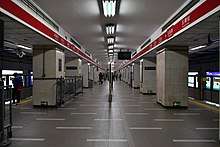
The first section of subway in Beijing officially started trial operation on January 15, 1971. It was 10.7 km (6.6 mi) long and ran between Beijing railway station to Gongzhufen[lower-alpha 1], which today is a section of Line 1 and 2.[12] A few months later, on August 15, 1971 the line was extended 3 stations west, to Yuquanlu. The line was extended again to Gucheng in November. On April 23, 1973, the line was extended Pingguoyuan, at this point the line is 23.6 km (14.7 mi) long with 17 stations.[12] On September 15, 1981 the line was again extended westward to Fushouling creating a 27.6 km (17.1 mi) long line with 19 stations. The line was transferred to the newly created Beijing Mass Transit Operation Corporation and was officially opened to the public, ending the decade long trial operation period. By 1981, the annual passenger volume of Beijing Subway was 64.66 million passengers, with a daily average of 177,000 passenger trips.[13]
On August 15, 1986, the second phase of subway construction started and a feasibility study on the construction of the new line between of Fuxingmen to Bawangfen (Today's Beijing CBD) was carried out. A new branch heading east to a new station, Fuxingmen, was completed between Nanlishilu and Changchunjie stations on December 28, 1987. The section between Changchunjie and Beijing Railway Station was transferred to the newly created Line 2 and Line 1 ran between Pingguoyuan and Fuxingmen stations. In January 1991, the feasibility study report on the construction of a new line between Fuxingmen to Bawangfen was approved with construction of the new "Fuba line", starting in June 1992. On December 12, 1992, Line 1 was extended east for one station to Xidan. In 1994, Line 1's signals were upgraded to automatic train protection system.[14] On September 28, 1999, the first section of the Fuba line between Tian'anmen East to Sihui East was opened. On June 28, 2000, the section between Xidan and Tian'anmen East stations opened, merging Line 1 and the Fuba Line to create a 31 km (19 mi) line with 23 stations.[14]
Due to platform congestion and suicides, a proposal was made in 2010 to refit all stations on Line 1 with platform screen doors.[15] However, the ventilation system in the older stations of Line 1 was incompatible with full-height platform screen doors, so half height platform screen doors were chosen instead.[16] In the meantime between 2014 and 2015, Line 1 again upgraded its signals to a communications-based train control system allowing trains to run headways down to 2 minutes during rush hour. In July 2016, the operator began installing platform screen doors on Line 1.[17] In 2016, the platform screen doors was installed at Yong'anli station.[18] By the end of 2017, all stations were retrofitted with half-height platform screen doors, and all the screen doors were put into operation for the first time.[19]
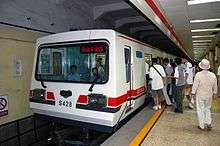 Line 1 train at Wangfujing in 2007. | 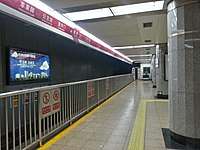 In 1992, Line 1 was extended east one station to Xidan. | Platform of Tian'anmen East station |  In 2017, safety doors were installed on the platform of Line 1. |
| Segment | Commencement | Length | Station(s) | Name |
|---|---|---|---|---|
| Gongzhufen — Beijing Railway Station | 1 October 1969[lower-alpha 2] | 10.7 km (6.65 mi) | 10 | Phase 1 (initial section) |
| Yuquanlu — Gongzhufen | 5 August 1971 | 4.9 km (3.04 mi) | 3 | Yuquanlu extension |
| Gucheng — Yuquanlu | 7 November 1971 | 5.4 km (3.36 mi) | 3 | Gucheng extension |
| Pingguoyuan — Gucheng | 23 April 1973 | 3.7 km (2.30 mi) | 1 | Pingguoyuan extension |
| Nanlishilu — Fuxingmen | 28 December 1987 | 0.4 km (0.25 mi) | 1 | Line 1 & 2 realignment project |
| Changchunjie — Beijing Railway Station | −6.1 km (−3.79 mi) | -6 | ||
| Fuxingmen — Xidan | 12 December 1992 | 1.6 km (0.99 mi) | 1 | Xidan extension |
| Tian'anmen West — Sihui East | 28 September 1999 | 10.1 km (6.28 mi) | 10 | Fuba line |
| Xidan — Tian'anmen West | 28 June 2000 | 1.3 km (0.81 mi) | 2 | Line 1 & Fuba line merging project |
- In 1970s, Gongzhufen was called Lixin (立新)
- 15 January 1971 - Initial line began operation on a trial basis.
Other facilities
Rolling stock for Line 1 is maintained at Gucheng and Sihui.
Restricted stations
Beyond Pingguoyuan, Line 1 extends further northwest where it has several other stations including 54# Heishitou (黑石头), 53#/No. 101 Gaojing (高井) and 52#/No. 102 Fushouling (福寿岭). Gaojing and Heishitou are in the military region. Fushouling is actually outside the military region. These stations are not open for public use.
Fushouling station will open to public in several years.[20] The station will also serve the nearby Beijing Banking & Insurance Business Park (北京银行保险产业园).[21]
Future plans
Through operations with the Batong Line
In 2010, a CPPCC member Chen Dingwang, proposed that services on Line 1 and the Batong Line should directly link, with through operations, reducing travel times and removing the unnecessary forced transfers at Sihui East or Sihui.[22] However, the Beijing Subway responded that Line 1's and Batong's signal systems are completely different, so through-operation will be more difficult to achieve, from an engineering standpoint. As of 2016, preliminary design and feasibility studies are underway to allow for through operations between Line 1 and Batong.[23]
The through operation will be started in 2021.[24]
Increasing capacity

Due to Line 1's severe overcapacity problem, there are plans to introduce seven-car or longer trains.[25] In order for this plan to proceed the oldest section of Line 1 between Pingguoyuan and Nanlishilu, which only has platforms long enough to accommodate six-car trains, will need to be lengthened. The newer section between Fuxingmen and Sihui East has platforms long enough for 8 car trains. Due to the high cost of extending the platforms of the underground stations the plan is currently put on hold. In the future a parallel express line called Line 18 will run beside or under Line 1 stopping only at major stations.
Rolling Stock
Current
| Model | Image | Manufacturer | Year Built | Year Refurbished | Amount in Service | Fleet Numbers | Depot |
|---|---|---|---|---|---|---|---|
| DKZ4 | 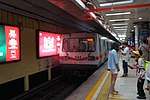 |
CRRC Changchun Railway Vehicles Beijing Subway Rolling Stock Equipment |
1998 | 2007 | 31 | S401–S431 | Sihui |
| SFM04 | 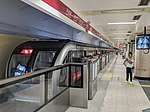 |
CRRC Qingdao Sifang Beijing Subway Rolling Stock Equipment |
2006 | Never | 39 | G432–G470 | Gucheng |
Former
| Model | Image | Manufacturer | Year Built | Year Retired | Number Made | Fleet Numbers | Depot |
|---|---|---|---|---|---|---|---|
| DK2 | CRRC Changchun Railway Vehicles | 1969 | 1984 (Refurbished into DK11) | 19 | 201–219 | Gucheng | |
| DK3 | CRRC Changchun Railway Vehicles | 1971 | 2005 | 7 | G101–G107 | Gucheng | |
| DK8 | CRRC Changchun Railway Vehicles | 1984 | 1986 (Refurbished to DK16) | 15 | T101–T104, T106–T108, T1093, T1094, T3023, T3024, T304 | Taiping Lake | |
| DK11 | 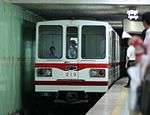 |
CRRC Changchun Railway Vehicles | 1984 | 2008 | 13 | G201–G213 | Gucheng |
| DK20 | CRRC Changchun Railway Vehicles | 1994 | 2012 | 7 | G108–G114 | Gucheng | |
| BD1 | Beijing Subway Rolling Stock Equipment | 1990 | 2008 | 4 | T129–T132 | Taiping Lake | |
| BD2 | Beijing Subway Rolling Stock Equipment | 1994 | 2012 | 12 | G115–G126 | Gucheng | |
| BD3 | Beijing Subway Rolling Stock Equipment | 1996 | 1999 | 1 | G2081, G2086 | Gucheng |
See also
- Restricted stations of Line 1, Beijing Subway
Notes
References
- 客流信息. Beijing Subway. Retrieved 2015-03-20.
- "Ridership". Sina. Retrieved 2012-05-03.
- "Official Ridership". Beijing Subway. Archived from the original on 2012-05-02. Retrieved 2012-05-04.
- Gao Yucai (高毓才) (1999). 建设中的北京地铁——地铁"复一八"线. Beijing: China Railways Press (中国铁道出版社). p. 13. ISBN 7-113-03381-4.
- Pan Xiaojun (潘晓军) (2013). 北京地铁1号线运输能力挖掘研究. 交通运输系统工程与信息. 13 (4): 200–204.
- "八通线与1号线贯通?年底见分晓". bjnews.com.cn. 2016-11-16.
- "北京地铁1号线福寿岭站将开放使用". Qianlongwang. 2018-09-28. Retrieved 2018-09-28.
- 我市轨道交通网络化运营效果凸显. Beijing Municipal Transportation Committee (北京市交通委员会). 2013-02-07. Archived from the original on 2014-01-09. Retrieved 2013-09-15.
- Archived October 24, 2008, at the Wayback Machine
- 北京地铁. Beijing Subway.
- "站间公里数 北京地铁官方网站".
- 地铁公司大事记1971--1980年. Beijing Subway.
- 地铁公司1981--1990年地铁大事记. Retrieved 2011-02-03.
- 地铁公司1991--2000年大事记. Beijing Subway. Archived from the original on 2011-01-31. Retrieved 2011-02-03.
- 北京地铁1号2号13号线和八通线将装站台安全门. Sohu. 2010-04-06.
- 北京地铁老线加装站台安全门已进入论证阶段. Archived from the original on 2013-04-10. Retrieved 2013-03-09. 大众网 2010-07-04
- "Beijing begins installing platform barriers on subway Line 1". China Daily. Xinhua. 2016-07-19. Retrieved 2019-07-11.
- 北京地铁1号线站台门 开关2000次后"上岗" - 财经新闻 - 中国网•东海资讯. jiangsu.china.com.cn. Archived from the original on 2016-08-21. Retrieved 2016-08-18.
- 1号线全线安全门今日投用 北京地铁全线安全门全部启用. news.sina.com.cn. 2017-09-10. Retrieved 2017-11-09.
- "北京市石景山区人民政府办公室关于印发《石景山区2019年交通综合治理行动计划》的通知". 2019-07-17.
- "重磅 1号线福寿岭站即将启用 建设北京·银行保险产业园至中关村西区、金融街半小时交通圈". 2019-07-31.
- 北京地铁八通线一号线有望贯通. 中国网. 2011-09-16.
- 北京八通线南延工程初步设计顺利通过评审-千龙网·中国首都网. finance.qianlong.com. Retrieved 2016-11-17.
- "地铁八通线问题". 2019-06-28. Retrieved 2019-12-04.
- 北京地铁1号线6节车厢将扩至7节. 凤凰网. 2010-12-31.
External links
